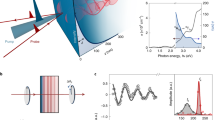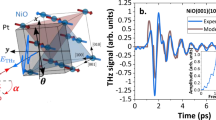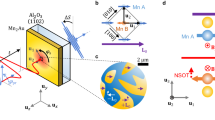Abstract
Magnon-mediated angular-momentum flow in antiferromagnets may become a design element for energy-efficient, low-dissipation and high-speed spintronic devices1,2. Owing to their low energy dissipation, antiferromagnetic magnons can propagate over micrometre distances3. However, direct observation of their high-speed propagation has been elusive due to the lack of sufficiently fast probes2. Here we measure the antiferromagnetic magnon propagation in the time domain at the nanoscale (≤50 nm) with optical-driven terahertz emission. In non-magnetic-Bi2Te3/antiferromagnetic-insulator-NiO/ferromagnetic-Co trilayers, we observe a magnon velocity of ~650 km s–1 in the NiO layer. This velocity far exceeds previous estimations of the maximum magnon group velocity of ~40 km s–1, which were based on the magnon dispersion measurements of NiO using inelastic neutron scattering4,5. Our theory suggests that for magnon propagation at the nanoscale, a finite damping makes the dispersion anomalous for small magnon wavenumbers and yields a superluminal-like magnon velocity. Given the generality of finite dissipation in materials, our results strengthen the prospects of ultrafast nanodevices using antiferromagnetic magnons.
This is a preview of subscription content, access via your institution
Access options
Access Nature and 54 other Nature Portfolio journals
Get Nature+, our best-value online-access subscription
$29.99 / 30 days
cancel any time
Subscribe to this journal
Receive 12 print issues and online access
$259.00 per year
only $21.58 per issue
Buy this article
- Purchase on Springer Link
- Instant access to full article PDF
Prices may be subject to local taxes which are calculated during checkout




Similar content being viewed by others
Data availability
Source data are provided with this paper. All other data that support the plots within this paper and other findings of this study are available from the Supplementary Information or the corresponding authors upon reasonable request.
Code availability
The code that has been used for this work is available from the corresponding authors upon reasonable request.
References
Chumak, A. V., Vasyuchka, V. I., Serga, A. A. & Hillebrands, B. Magnon spintronics. Nat. Phys. 11, 453–461 (2015).
Hou, D., Qiu, Z. & Saitoh, E. Spin transport in antiferromagnetic insulators: progress and challenges. NPG Asia Mater. 11, 35 (2019).
Lebrun, R. et al. Tunable long-distance spin transport in a crystalline antiferromagnetic iron oxide. Nature 561, 222–225 (2018).
Hutchings, M. T. & Samuelsen, E. J. Measurement of spin-wave dispersion in NiO by inelastic neutron scattering and its relation to magnetic properties. Phys. Rev. B 6, 3447–3461 (1972).
Gomonay, O., Jungwirth, T. & Sinova, J. High antiferromagnetic domain wall velocity induced by Néel spin-orbit torques. Phys. Rev. Lett. 117, 017202 (2016).
Kampfrath, T. et al. Coherent terahertz control of antiferromagnetic spin waves. Nat. Photon. 5, 31–34 (2011).
Cheng, R., Xiao, D. & Brataas, A. Terahertz antiferromagnetic spin Hall nano-oscillator. Phys. Rev. Lett. 116, 207603 (2016).
Li, J. et al. Spin current from sub-terahertz-generated antiferromagnetic magnons. Nature 578, 70–74 (2020).
Vaidya, P. et al. Subterahertz spin pumping from an insulating antiferromagnet. Science 368, 160–165 (2020).
Olejník, K. et al. Terahertz electrical writing speed in an antiferromagnetic memory. Sci. Adv. 4, eaar3566 (2018).
Shiino, T. et al. Antiferromagnetic domain wall motion driven by spin-orbit torques. Phys. Rev. Lett. 117, 087203 (2016).
Lan, J., Yu, W. & Xiao, J. Antiferromagnetic domain wall as spin wave polarizer and retarder. Nat. Commun. 8, 178 (2017).
Daniels, M. W., Cheng, R., Yu, W., Xiao, J. & Xiao, D. Nonabelian magnonics in antiferromagnets. Phys. Rev. B 98, 134450 (2018).
Rezende, S. M., Azevedo, A. & Rodríguez-Suárez, R. L. Introduction to antiferromagnetic magnons. J. Appl. Phys. 126, 151101 (2019).
Brataas, A., van Wees, B., Klein, O., de Loubens, G. & Viret, M. Spin insulatronics. Phys. Rep. 885, 1–27 (2020).
Kampfrath, T. et al. Terahertz spin current pulses controlled by magnetic heterostructures. Nat. Nanotechnol. 8, 256–260 (2013).
Wu, Y. et al. High-performance THz emitters based on ferromagnetic/nonmagnetic heterostructures. Adv. Mater. 29, 1603031 (2017).
Wang, H., Du, C., Hammel, P. C. & Yang, F. Antiferromagnonic spin transport from Y3Fe5O12 into NiO. Phys. Rev. Lett. 113, 097202 (2014).
Li, C. H., van’t Erve, O. M. J., Yan, C., Li, L. & Jonker, B. T. Electrical detection of charge-to-spin and spin-to-charge conversion in a topological insulator Bi2Te3 using BN/Al2O3 hybrid tunnel barrier. Sci. Rep. 8, 10265 (2018).
Nogués, J. & Schuller, I. K. Exchange bias. J. Magn. Magn. Mater. 192, 203–232 (1999).
Ma, L. Y. et al. NiO-thickness dependent magnetic anisotropies in Fe/NiO/Au(001) and Fe/NiO/MgO(001) systems. J. Magn. Magn. Mater. 324, 528–533 (2012).
Braun, L. et al. Ultrafast photocurrents at the surface of the three-dimensional topological insulator Bi2Se3. Nat. Commun. 7, 13259 (2016).
Beaurepaire, E. et al. Coherent terahertz emission from ferromagnetic films excited by femtosecond laser pulses. Appl. Phys. Lett. 84, 3465–3467 (2004).
Higuchi, T., Kanda, N., Tamaru, H. & Kuwata-Gonokami, M. Selection rules for light-induced magnetization of a crystal with threefold symmetry: the case of antiferromagnetic NiO. Phys. Rev. Lett. 106, 047401 (2011).
Wang, Y. et al. Magnetization switching by magnon-mediated spin torque through an antiferromagnetic insulator. Science 366, 1125–1128 (2019).
Qiu, H. et al. Ultrafast spin current generated from an antiferromagnet. Nat. Phys. 17, 388–394 (2021).
Malozemoff, A. P. Random-field model of exchange anisotropy at rough ferromagnetic-antiferromagnetic interfaces. Phys. Rev. B 35, 3679–3682 (1987).
Haldane, F. D. M. Nonlinear field theory of large-spin Heisenberg antiferromagnets: semiclassically quantized solitons of the one-dimensional easy-axis Néel state. Phys. Rev. Lett. 50, 1153–1156 (1983).
Caretta, L. et al. Relativistic kinematics of a magnetic soliton. Science 370, 1438–1442 (2020).
Garrett, C. G. B. & McCumber, D. E. Propagation of a Gaussian light pulse through an anomalous dispersion medium. Phys. Rev. A 1, 305–313 (1970).
Wang, L. J., Kuzmich, A. & Dogariu, A. Gain-assisted superluminal light propagation. Nature 406, 277–279 (2000).
Bigelow, M. S., Lepeshkin, N. N. & Boyd, R. W. Superluminal and slow light propagation in a room-temperature solid. Science 301, 200–202 (2003).
Moriyama, T. et al. Intrinsic and extrinsic antiferromagnetic damping in NiO. Phys. Rev. Mater. 3, 051402 (2019).
Khymyn, R., Lisenkov, I., Tiberkevich, V. S., Slavin, A. N. & Ivanov, B. A. Transformation of spin current by antiferromagnetic insulators. Phys. Rev. B 93, 224421 (2016).
Dąbrowski, M. et al. Coherent transfer of spin angular momentum by evanescent spin waves within antiferromagnetic NiO. Phys. Rev. Lett. 124, 217201 (2020).
Acknowledgements
We thank D. Zhao and E. Chia for discussion of THz measurements and H.-W. Lee, J. H. Oh and K.-W. Kim for fruitful discussions of theory. The work is partially supported by the SpOT-LITE program (A*STAR grant, A18A6b0057), AME-IRG (grant no. A1983c0037) through RIE2020 funds and a National Research Foundation of Korea Investigatorship (NRFI06-2020-0015). D.-K.L. and K.-J.L. were supported by the National Research Foundation of Korea, funded by the Ministry of Science and ICT (2020R1A2C3013302). S.K.K. was supported by the Brain Pool Plus Program through the National Research Foundation of Korea, funded by the Ministry of Science and ICT (grant no. NRF-2020H1D3A2A03099291) and by the National Research Foundation of Korea, funded by the Korean government via the SRC Center for Quantum Coherence in Condensed Matter (grant no. NRF-2016R1A5A1008184). Q.X. acknowledges support from the State Key Laboratory of Low-Dimensional Quantum Physics and a start-up grant from Tsinghua University.
Author information
Authors and Affiliations
Contributions
K.L. and D.Y. grew the films. K.L. performed the X-ray diffraction and the vibrating sample magnetometer and THz experiments, and performed the data analysis with R.M. and D.-J.K.; D.-K.L, S.K.K. and K.-J.L. developed the theoretical model and performed the atomistic calculation. S.L. and Q.X. performed the Raman experiments. H.Y. conceived this work and supervised the project. K.L., D.-K.L., R.M., K.-J.L. and H.Y. wrote the manuscript. All authors discussed the results and commented on the manuscript.
Corresponding authors
Ethics declarations
Competing interests
The authors declare no competing interests.
Additional information
Peer review information Nature Nanotechnology thanks the anonymous reviewers for their contribution to the peer review of this work.
Publisher’s note Springer Nature remains neutral with regard to jurisdictional claims in published maps and institutional affiliations.
Extended data
Extended Data Fig. 1 THz emission from Bi2Te3 via the shift current generation.
a, THz waveform emitted from the Bi2Te3 (6 nm) film. The optical polarization is set to be parallel (θP = 0°) or perpendicular (θP = 90°) to the laboratorial horizontal-direction. b, The sample azimuthal angle dependent THz peak amplitudes. Symbols and lines represent the experimental data and sinusoidal fits, respectively. A three-fold symmetry with respect to the sample azimuthal angle is obtained, which reflects the three-fold crystal structure of Bi2Te3. Moreover, the THz polarity is reversed with two linear optical polarization angles. Overall, these THz amplitudes and polarity trends are in good agreement with the shift current induced THz emission in a single Bi2Te3 layer. c, Crystal structure of Bi2Te3. For further discussion, see Supplementary Note 1.3.
Extended Data Fig. 2 Magnetic dipole radiation effects.
The magnetic dipole radiation contributions from both Co and NiO to the THz signal should be taken into consideration in order to evaluate the magnon velocity since they are not related to the magnon propagation. THz emission signals from Co, NiO and Bi2Te3/Co are displayed. The displayed THz signal from Bi2Te3/Co is divided by 100 from the original signal for eye guidance. No observable THz emission is found from NiO (50 nm). The THz magnitude from Co (3 nm), calibrated with the THz transmission ratio through a Bi2Te3 layer (0.375), is as small as ~ 0.3% of the THz signal from the Bi2Te3/Co bilayer. The magnetic dipole radiation effects on the THz signal from Bi2Te3/NiO (d)/Co are therefore found to be negligible. For further discussion, see Supplementary Note 1.1.
Extended Data Fig. 3 NiO/Co interfacial effects.
a, THz emission signals from NiO (d)/Co. b, The peak amplitude trend on d. The data points and the error bars represent the mean values and the standard deviation for five measurements, respectively. From the THz emission measurements from NiO (d)/Co, one can estimate both the magnetic dipole radiation effects and the NiO/Co interfacial effect. The time-shift of the THz signal from NiO/Co (ENiO/Co) for various d is found to be small but finite (< 50 fs). We note that, on the other hand, the amplitudes of ENiO/Co were two orders of magnitude smaller than the THz signal from Bi2Te3/NiO (d)/Co, and thereby its effect on the THz signal relevant to the magnon propagation (that is, ESCC) is negligibly small. This small effect, however, should be taken into consideration for calculating accurate magnon velocities. For further discussion, see Supplementary Note 1.2.
Extended Data Fig. 4 Bi2Te3/NiO interfacial effects.
a–c, THz emission signals from Bi2Te3 (6 nm)/NiO (0, 20 and 50 nm), respectively. E1 and E2 are the THz signals for the horizontal and vertical optical polarization, respectively. The odd components, (E1-E2)/2, are well overlapped with E1, whereas the even components, (E1+E2)/2, are negligibly small for all cases. This reveals that the spin current generation of the NiO layer itself is negligible. For further discussion, see Supplementary Note 1.4.
Extended Data Fig. 5 Bi2Te3/NiO interfacial effects.
THz signals based on the spin-to-charge conversion (ESSC) from Bi2Te3/NiO, Bi2Te3/NiO/Co and Bi2Te3/Cu/NiO/Co. For further discussion, see Supplementary Note 1.6.
Extended Data Fig. 6 Decomposition of THz emission signals with respect to the optical excitation polarization.
a, Schematics of the THz emission measurements for the orthogonal angles (θP) of optical polarization at a fixed sample azimuthal angle (φ = 0°). b–h, THz emission signals from Bi2Te3/NiO (d)/Co for d = 0–50 nm, respectively. The THz signal only relevant to the spin-to-charge conversion, ESCC, is derived by (E1 + E2)/2 – ENiO/Co. Here, E1 and E2 are the THz signals for the horizontal (θP = 0°) and vertical (θP = 90°) optical polarization, respectively. ENiO/Co is the THz signal from the NiO/Co bilayers. For further discussion, see Supplementary Note 1.3.
Extended Data Fig. 7 NiO/Co interfacial effects on the magnon propagation.
a, Delay times and b, Magnon velocity extracted without (red square) and with (blue circle) compensating ENiO/Co from the even component, (E1 + E2)/2. Here, E1 and E2 are the THz signals for the horizontal and vertical optical polarization, respectively. ENiO/Co is the THz signal from the NiO/Co bilayers. The data points and the error bars represent the mean values and the standard deviation for five measurements, respectively. For further discussion, see Supplementary Note 1.3.
Extended Data Fig. 8 Comparison of the sample properties between Bi2Te3-based and Pt-based trilayers.
a,b, X-ray diffraction data, c,d, Vibrating sample magnetometer hysteresis loops, and e,f, their NiO thickness trends. The error bars for the X-ray diffraction and coercivity trends represent the standard deviation obtained from Lorentzian and sigmoidal fits, respectively. For further discussion, see Supplementary Note 2.
Extended Data Fig. 9 Comparison of THz emission and magnon velocity between Bi2Te3-based and Pt-based trilayers.
a,b, THz emission signals for various NiO thicknesses. c,d, NiO thickness trends on the THz amplitude and magnon velocity. The data points and the error bars represent the mean values and the standard deviation for five measurements, respectively. For further discussion, see Supplementary Note 2.
Extended Data Fig. 10 Analytically and numerically obtained magnon dispersion and magnon velocity in the presence of damping.
The lines are from analytic equations in the main text and symbols are from numerical modeling. a, Magnon dispersions of acoustic mode at various damping constants. b, Imaginary part of wavenumber \((k_ + ^{{{{\mathrm{IM}}}}})\) as a function of the real part of wavenumber \((k_ + ^{{{{\mathrm{RE}}}}})\). c, The magnon group velocity of acoustic mode as a function of \(k_ + ^{{{{\mathrm{RE}}}}}\). For further discussion, see Supplementary Note 6.
Supplementary information
Supplementary Information
Supplementary Notes 1–9 and Figs. 1–8.
Source data
Source Data Fig. 2
Source data for Fig. 2b–d.
Source Data Fig. 3
Source data for Fig. 3a–d.
Source Data Fig. 4
Source data for Fig. 4a,b.
Source Data Extended Data Fig. 1
Source data for Extended Data Fig. 1a,b.
Source Data Extended Data Fig. 2
Source data for Extended Data Fig. 2.
Source Data Extended Data Fig. 3
Source data for Extended Data Fig. 3a,b.
Source Data Extended Data Fig. 4
Source data for Extended Data Fig. 4a–c.
Source Data Extended Data Fig. 5
Source data for Extended Data Fig. 5.
Source Data Extended Data Fig. 6
Source data for Extended Data Fig. 6b–h.
Source Data Extended Data Fig. 7
Source data for Extended Data Fig. 7a,b.
Source Data Extended Data Fig. 8
Source data for Extended Data Fig. 8a–f.
Source Data Extended Data Fig. 9
Source data for Extended Data Fig. 9a–d.
Source Data Extended Data Fig. 10
Source data for Extended Data Fig. 10a,b.
Rights and permissions
About this article
Cite this article
Lee, K., Lee, DK., Yang, D. et al. Superluminal-like magnon propagation in antiferromagnetic NiO at nanoscale distances. Nat. Nanotechnol. 16, 1337–1341 (2021). https://doi.org/10.1038/s41565-021-00983-4
Received:
Accepted:
Published:
Issue Date:
DOI: https://doi.org/10.1038/s41565-021-00983-4
This article is cited by
-
Coherent antiferromagnetic spintronics
Nature Materials (2023)



